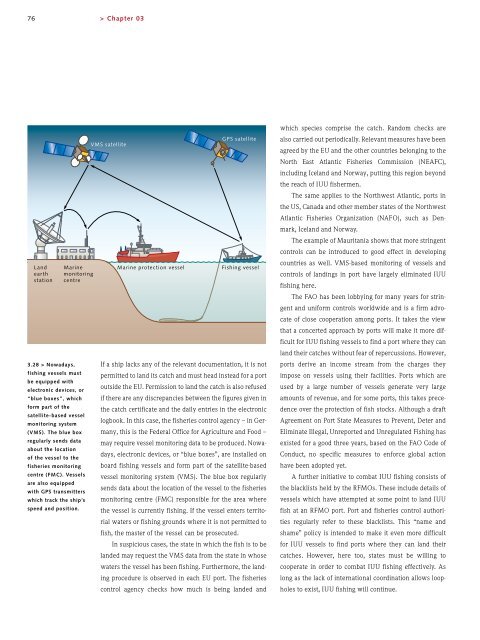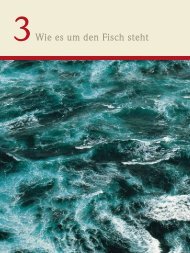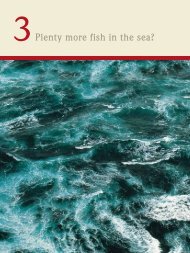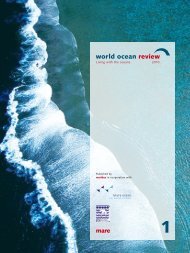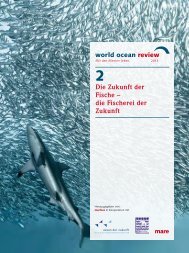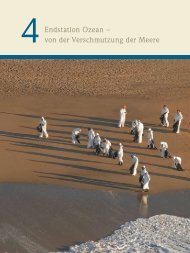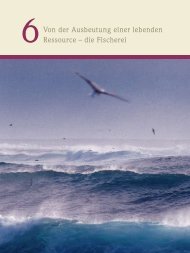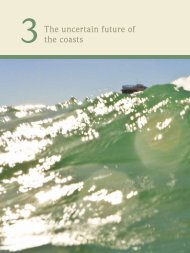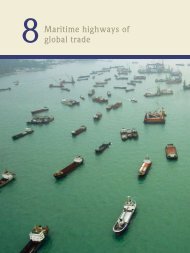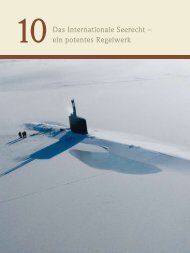Download WOR 2 PDF - World Ocean Review
Download WOR 2 PDF - World Ocean Review
Download WOR 2 PDF - World Ocean Review
Create successful ePaper yourself
Turn your PDF publications into a flip-book with our unique Google optimized e-Paper software.
76> Chapter 03LandearthstationMarinemonitoringcentre3.28 > Nowadays,fishing vessels mustbe equipped withelectronic devices, or“blue boxes”, whichform part of thesatellite-based vesselmonitoring system(VMS). The blue boxregularly sends dataabout the locationof the vessel to thefisheries monitoringcentre (FMC). Vesselsare also equippedwith GPS transmitterswhich track the ship’sspeed and position.VMS satelliteMarine protection vesselGPS satelliteFishing vesselIf a ship lacks any of the relevant documentation, it is notpermitted to land its catch and must head instead for a portoutside the EU. Permission to land the catch is also refusedif there are any discrepancies between the figures given inthe catch certificate and the daily entries in the electroniclogbook. In this case, the fisheries control agency – in Germany,this is the Federal Office for Agriculture and Food –may require vessel monitoring data to be produced. Nowadays,electronic devices, or “blue boxes”, are installed onboard fishing vessels and form part of the satellite-basedvessel monitoring system (VMS). The blue box regularlysends data about the location of the vessel to the fisheriesmonitoring centre (FMC) responsible for the area wherethe vessel is currently fishing. If the vessel enters territorialwaters or fishing grounds where it is not permitted tofish, the master of the vessel can be prosecuted.In suspicious cases, the state in which the fish is to belanded may request the VMS data from the state in whosewaters the vessel has been fishing. Furthermore, the landingprocedure is observed in each EU port. The fisheriescontrol agency checks how much is being landed andwhich species comprise the catch. Random checks arealso carried out periodically. Relevant measures have beenagreed by the EU and the other countries belonging to theNorth East Atlantic Fisheries Commission (NEAFC),including Iceland and Norway, putting this region beyondthe reach of IUU fishermen.The same applies to the Northwest Atlantic, ports inthe US, Canada and other member states of the NorthwestAtlantic Fisheries Organization (NAFO), such as Denmark,Iceland and Norway.The example of Mauritania shows that more stringentcontrols can be introduced to good effect in developingcountries as well. VMS-based monitoring of vessels andcontrols of landings in port have largely eliminated IUUfishing here.The FAO has been lobbying for many years for stringentand uniform controls worldwide and is a firm advocateof close cooperation among ports. It takes the viewthat a concerted approach by ports will make it more difficultfor IUU fishing vessels to find a port where they canland their catches without fear of repercussions. However,ports derive an income stream from the charges theyimpose on vessels using their facilities. Ports which areused by a large number of vessels generate very largeamounts of revenue, and for some ports, this takes precedenceover the protection of fish stocks. Although a draftAgreement on Port State Measures to Prevent, Deter andEliminate Illegal, Unreported and Unregulated Fishing hasexisted for a good three years, based on the FAO Code ofConduct, no specific measures to enforce global actionhave been adopted yet.A further initiative to combat IUU fishing consists ofthe blacklists held by the RFMOs. These include details ofvessels which have attempted at some point to land IUUfish at an RFMO port. Port and fisheries control authoritiesregularly refer to these blacklists. This “name andshame” policy is intended to make it even more difficultfor IUU vessels to find ports where they can land theircatches. However, here too, states must be willing tocooperate in order to combat IUU fishing effectively. Aslong as the lack of international coordination allows loopholesto exist, IUU fishing will continue.


